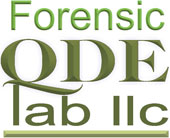In this world of rapidly-changing technology and complex litigation, how does one know for sure what kind of expert to hire? For every problem to solve, there is an niche with experts willing to help. More often than not, a complicated case requires more than one expert. If you are not sure if you need a handwriting expert, a printing specialist, or an ink analysis for your documents, allow me to clarify what I have come to understand as the parameters of a Forensic Document Examiner (FDE).
Handwriting
Most people in the justice system have relied on the testimony or conclusions of an FDE for handwriting analysis. Not the analysis that some would recognize as personality typing, but the examination of handwriting for the purposes of identifying or eliminating a writer. This is undoubtedly most common service we provide and the one that requires, in my opinion, the most training and experience to perform. Some FDE’s spend their entire careers becoming proficient in the myriad nuances of handwriting analysis. Others find that they enjoy the other aspects of our field, some becoming specialists in those areas.
Typewritten Materials
One such specialty is the typewriter identification. The high tech of the 20th century is now considered the dinosaur of communication by some. But the fact is that the typewriter is still in use, especially in foreign countries, and there still remain typewritten documents that come into question. Typewriting examinations were often needed for similar reasons as handwriting, back in the day – to identify a machine, or even a particular typist! Nowadays, FDE’s analyze typed documents to determine such things as; whether or not the typewritten material was produced by the same machine throughout; whether or not it was produced by a machine appropriate to the time frame of a dated document; or if there were alterations or additions to the document that do not match the overall page layout. FDE’s should have a working knowledge of how to analyze the output of the typewriter, but most FDE’s rarely see a typewriting case. While the basics of analysis apply and can be accomplished by most FDE’s, many prefer to refer such cases to examiners who have more familiarity with typewritten documents. Remember, everything I have mentioned here applies to original documents.
Copies and Printing Processes
That brings me to the subject of copies. This is and will continue to be the topic of much consternation among document examiners. There are more ways to produce and reproduce documents than there are document examiners to discover them. And what do we get most often to opine upon? You guessed it…copies. It is a good day when I receive original documents to examine. Instead, we are asked to determine the authenticity or integrity of documents based on the rendition of the copy produced, relying on the integrity of the source of the copy. And, by the way, how many times has this document been copied and recopied, anyway?
FDE’s examine copies in lieu of originals because they are the only image of the original available. From the copies we receive online or directly we are asked to determine whether or not the document or its contents are authentic or have been altered in some way. We do handwriting analyses and other examinations, but the details of the original could have been lost during the copying process and therefore the confidence level of the opinion is limited.
The printed image is not the only part of a copy we look at; there is other information that can be gathered from a copy. Photocopy machines or printing devices sometimes leave unique markings on the printout that could identify the source of the document. Or, the copy of the document my have telltale indentations left there from a sheet that was written on while on top of the copy. So, just because you only have a copy to analyze, there may be valuable forensic evidence hidden within.
Ink
Sometimes we get calls asking if we can tell how old the ink is on a document. The answer is, not necessarily. We do know, for instance, that an ink line made with a pen such as roller ball would not have been made before 1970, so there would be something fishy with a will dated 1962, signed with a rollerball pen. Or we could potentially tell that there was more than one ink used to write the document. As for identifying the ink or the date of availability of the ink, we leave that to a handful of forensic ink chemists here in the US who can break the ink down into its chemical components. Their work requires that tiny portions of the ink line be removed from the document so it can be analyzed. Some ink chemists are also forensic document examiners and would complete an entire case in their lab if you choose. Quite often, a thorough (non-destructive) examination will produce enough valuable information without sending the document to an ink chemist.
Comparing Known to Questioned
Most of our work boils down to comparing what we know to be genuine to documents that have questionable origins. In the case of handwriting, we compare the known genuine handwriting to the writing in question to determine whether or not both were written by the same person.
So, if you . . .
- think you may have a document that is a fake
- question whether the document was signed by the person named
- wonder whether parts of a document have been altered
- want to identify handwriting
- need an expert to testify to the evidence in court
YOU NEED A FORENSIC DOCUMENT EXAMINER.
